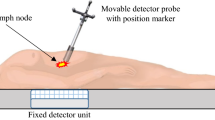Abstract
For radio-guided surgery on tumors using F-18-FDG, detection of annihilation gamma photons emanating from other parts of the body produces background radiation counts and limits its use in clinical situations. To overcome this limitation, we have developed an intra-operative positron probe with background-rejection capability. The positron probe uses a phoswich detector composed of a plastic scintillator and a bismuth germinate (BGO). A positron from a positron emitter such as F-18 is detected by the plastic scintillator and emits annihilation photons. The BGO detects one of the annihilation photons while a photo-multiplier tube (PMT) detects scintillation photons from both scintillators. The decay time differences of these two scintillators are used to distinguish whether the event is a true event where a positron and a following annihilation photon are detected simultaneously, or a background event. In this configuration, only positrons can be selectively detected, even in an environment of high background gamma photon flux. Spatial resolution was 11-mm full width at half maximum (FWHM) 5 mm from the detector surface. Measured sensitivity for the F-18 point source was 2.6 cps/kBq 5 mm from the detector surface. The background count rate was less than 0.5 cps for a 20-cm diameter cylindrical phantom containing 37 MBq of F-18 solution measured on the phantom surface, while the positron count rate was almost linear over a range of approximately 6 kcps. These results indicate that our developed intra-operative positron probe is valuable for radio-guided surgery on tumors using F-18-FDG in a high flux of background annihilation gamma photons.
Similar content being viewed by others
References
Hoffman EJ, Tornai MP, Janecek M, Patt BE, Iwanczyk JS. Intraoperative probes and imaging probes.Eur J Nucl Med 1999; 26 (8): 913–935.
Britten AJ. A method to evaluate intra-operative gamma probes for sentinel lymph node localization.Eur J Nucl Med 1999; 26 (2): 76–83.
Essner R, Hsueh EC, Haigh PI, Glass EC, Huynh Y, Daghighian F. Application of an F-18-fluorodeoxyglucose- sensitive probe for the intraoperative detection of malignancy.J Surg Res 2001; 96: 120–126.
Zervos EE, Desai DC, Depalatis LR, Soble D, Martin EW. F-18-labeled fluorodeoxyglucose positron emission tomography- guided surgery for recurrent colorectal cancer: a feasibility study.J Surg Res 2001; 97: 9–13.
Desai DC, Arnold M, Saha S, Hinkle G, Soble D, Fry J, et al. Correlative whole-body FDG-PET and intraoperative gamma detection of FDG distribution in colorectal cancer.Clinical Positron Imaging 2000; 3 (5): 189–194.
Lederman RJ, Raylman RR, Fisher SJ, Kison PV, San H, Nabel EG, et al. Detection of atherosclerosis using a novel positron-sensitive probe and 18-fluorodeoxyglucose (FDG).Nucl Med Commun 2001; 22 (7): 747–753.
Raylman RR, Wahl RL. A fiber-optically coupled positron- sensitive surgical probe.J Nucl Med 1994; 35 (5): 909–913.
Raylman RR, Wahl RL. Evaluation of ion-implanted-silicon detectors for use in intraoperative positron-sensitive probes.Med Phys 1996; 23 (11): 1889–1895.
Raylman RR, Fisher SJ, Brown RS, Ethier SP, Wahl RL. Fluorine 18-fluorodeoxyglucose-guided breast cancer surgery with a positron-sensitive probe: validation in preclinical studies.J Nucl Med 1995; 36 (10): 1869–1874.
Raylman RR. Performance of a dual, solid-state intraoperative probe system with F-18, Tc-99m, and In-111.J Nucl Med 2001; 42 (2): 352–360.
Daghighian F, Mazziotta JC, Hoffman EJ, Shenderov P, Eshaghian B, Siegel S, et al. Intraoperative beta probe: a device for detecting tissue labeled with positron or electron emitting isotopes during surgery.Med Phys 1994; 21 (1): 153–157.
Yasuda S, Makuuchi H, Fujii H, Nakasaki H, Mukai M, Sadahiro S, et al. Evaluation of a surgical gamma probe for detection of18F-FDG.Tokai J Exp Clin Med 2000; 25 (3): 93–99.
Levin CS, Tornai MP, MacDonald LR, et al. Annihilation gamma ray background characterization and rejection for a small beta camera used for tumor localization during surgery.IEEE Trans Nucl Sci 1997; 44: 1120–1126.
Tornai MP, Levin CS, MacDonald LR, et al. A miniature phoswich detector for gamma-ray localization and beta imaging.IEEE Trans Nucl Sci 1998; 45: 1166–1173.
Yamamoto S, Tarutani K, Suga M, Minato K, Watabe H, Iida H. Development of a phoswich detector for a continuous blood sampling system.IEEE Trans Nucl Sci 2001; 48: 1408–1411.
Yamamoto S, Matsumoto K, Senda M. Optimum threshold setting for a positron-sensitive probe with background rejection capability.Ann Nucl Med 2004; 18 (3): 251–256.
Author information
Authors and Affiliations
Corresponding author
Rights and permissions
About this article
Cite this article
Yamamoto, S., Matsumoto, K., Sakamoto, S. et al. An intra-operative positron probe with background rejection capability for FDG-guided surgery. Ann Nucl Med 19, 23–28 (2005). https://doi.org/10.1007/BF02986331
Received:
Accepted:
Issue Date:
DOI: https://doi.org/10.1007/BF02986331




